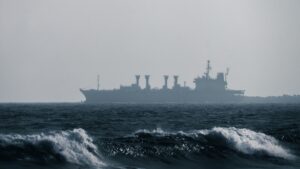Navigating the Complexities of Maritime Threats in International Waters


International waters serve as the arteries of global trade, transporting essential goods, energy resources, and raw materials between continents. Every day, thousands of vessels traverse these vast stretches of ocean, linking markets and enabling international cooperation. However, the same openness that allows commerce to thrive also makes these areas vulnerable to security challenges. Because no single nation has authority over international waters, they often become contested spaces where enforcing rules is challenging. Consequently, maritime threats thrive in such environments, posing dangers to both commercial and governmental vessels.
Moreover, the strategic importance of these waters extends beyond economics. Naval forces operate in international seas to project power, deter aggression, and ensure freedom of navigation. This dual use—both commercial and military—means that any disruption can have a ripple effect across global security. For this reason, understanding maritime threats is not only a matter of protecting shipping lanes but also a crucial element in preserving international stability.
Piracy and Armed Robbery at Sea
Piracy remains one of the most persistent maritime threats, despite international efforts to curb it. Regions such as the Gulf of Aden and the Strait of Malacca have long histories of pirate activity, often targeting merchant vessels for ransom or cargo theft. These attacks disrupt shipping schedules, increase insurance costs, and put crew members at risk. Although coordinated naval patrols have reduced incidents in some hotspots, piracy adapts quickly to shifting enforcement strategies, making it a continuing challenge for maritime security.
Equally concerning is armed robbery at sea, which occurs closer to shorelines and within territorial waters. Unlike piracy, which happens on the high seas, armed robbery targets vessels in ports or coastal routes. This crime undermines local economies and weakens the confidence of international shippers who rely on safe ports of call. Together, piracy and armed robbery demonstrate how maritime threats exploit vulnerable areas, highlighting the need for constant vigilance and adaptive countermeasures.
Smuggling and Trafficking Across Oceans
Another dimension of maritime threats involves smuggling and trafficking operations that exploit the vastness of international waters. Criminal networks use ships to transport illicit goods ranging from narcotics to counterfeit products. These activities not only erode the rule of law but also generate funds that often fuel other forms of organized crime. The difficulty of inspecting every vessel at sea makes smuggling particularly difficult to detect, creating opportunities for traffickers to flourish under limited surveillance.
Human trafficking also poses a grave concern. Migrants are often transported across dangerous waters in unseaworthy vessels, risking their lives while enriching traffickers. Such operations frequently exploit weak maritime governance and strained coastal resources. International collaboration is critical to addressing this issue, but the clandestine nature of trafficking makes it one of the most complex naval threats to eliminate. Nevertheless, consistent enforcement and intelligence-sharing can help disrupt these harmful networks.
Environmental and Ecological Risks
Beyond criminal activities, environmental hazards also qualify as maritime threats in international waters. Oil spills, illegal dumping, and unregulated fishing damage marine ecosystems, undermining both biodiversity and the livelihoods of coastal communities. Because these waters fall outside national jurisdictions, enforcement of environmental regulations often proves challenging. The lack of accountability can encourage reckless behavior, leading to long-term ecological harm.
In addition, climate change is intensifying these risks by altering sea routes, melting polar ice caps, and increasing the frequency of extreme weather events. Ships must adapt to new hazards such as stronger storms or shifting icebergs, which complicate navigation and heighten the chances of accidents. Addressing these environmental maritime threats requires global cooperation, as no single nation can safeguard the oceans alone. Effective solutions must combine sustainable practices, technological innovation, and multilateral agreements to achieve lasting impact.
Terrorism and State-Sponsored Aggression
International waters also serve as potential arenas for terrorism and state-sponsored aggression. Terrorist groups may target commercial shipping or offshore infrastructure to disrupt economies and spread fear. While large-scale maritime terrorism remains rare, even isolated incidents can have global repercussions by shaking confidence in marine security. The attack on the USS Cole in 2000 illustrates how devastating such operations can be when executed against unprepared targets.
Similarly, state-sponsored aggression, such as unauthorized naval blockades or military confrontations, adds another layer of complexity. Disputes over territorial claims often spill into international waters, where rival navies flex their strength. These standoffs can escalate quickly, threatening not just regional but also international peace. Therefore, understanding and mitigating such maritime threats requires both diplomatic engagement and credible deterrence.
Enhancing Maritime Security Through Cooperation
Given the wide range of maritime threats, international cooperation emerges as the most effective defense. Nations pool resources through joint naval patrols, information-sharing agreements, and multinational exercises. Such efforts create a coordinated front against piracy, smuggling, and terrorism. Furthermore, advances in technology, such as satellite surveillance and unmanned aerial systems, strengthen the ability to monitor vast ocean spaces more efficiently.
Nevertheless, cooperation is not without its challenges. Political rivalries, uneven resources, and differing national interests can hinder collective action. Yet, history shows that progress is possible when states recognize the shared value of secure international waters. By prioritizing collaboration over competition, countries can create a safer maritime environment that benefits commerce, security, and ecological sustainability alike.
International waters are both a gateway to prosperity and a frontier of risk. From piracy and smuggling to environmental hazards and geopolitical tensions, maritime threats test the resilience of global security systems. Although the challenges are daunting, they are not insurmountable. With consistent vigilance, technological innovation, and international cooperation, the world can safeguard its maritime commons.





